FACT SHEET
Beef Grading
Daryl Tatum, Ph.D.| Department of Animal Science, Colorado State University| Ft. Collins, CO
The grade of a beef cut sold at retail can be an important selection factor for many consumers. Likewise, the grade of a beef carcass is critical to the beef producer, since the dollar value received is directly dependent upon the grade. Yet consumers and producers alike often are confused as to what grades mean, and how they are determined.
Purpose of Beef Grading
The U.S. Department of Agriculture (USDA) has established Standards for Grades of Slaughter Cattle
and Standards for Grades of Carcass Beef (USDA, 1996), which are designed to facilitate beef marketing by separating a highly variable population of live cattle and/or beef carcasses into groups which are more uniform in quality and composition. Beef carcass grading is a voluntary service of the USDA, and the user (the packer) is charged a fee for the service. Grades are determined by an employee of the USDA, working independently of both the producer and packer. The USDA Standards include two separate grade designations – Quality Grades and Yield Grades – and are designated by the stamps shown in Figure 1. A carcass may be either Quality graded, or Yield graded, or both Quality and Yield graded at the same time.
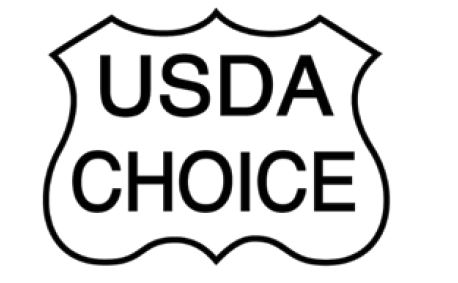
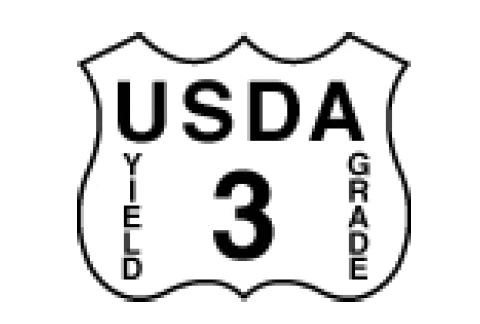
Quality Grading
Beef quality refers to the expected eating characteristics (tenderness, juiciness and flavor) of the cooked product. USDA Quality Grades are used to reflect differences in expected eating quality among slaughter cattle and their carcasses. There are eight USDA Quality Grades for beef:
USDA Prime
USDA Choice
USDA Select
USDA Standard
USDA Commercial
USDA Utility
USDA Cutter
USDA Canner
Eating quality generally is most desirable for “Prime beef” and least desirable for “Canner beef”. The Quality Grade of a beef carcass is determined by evaluating carcass indicators of physiological maturity and marbling, as reflected in the Official USDA Grading Chart (Figure 2).
Maturity
The age of a beef animal has a direct effect on tenderness of the meat it produces. As cattle mature, their meat becomes progressively tougher. To account for the effects of the maturing process on beef tenderness, evaluations of carcass maturity are used in determining USDA Quality Grades. There are five maturity groupings, designated as A through E. Approximate ages corresponding to each maturity classification are:
A — 9 to 30 months
B — 30 to 42 months
C — 42 to 72 months
E — more than 96 month

1Assumes the firmness of lean is comparablly developed with the degree of marbling and that the carcass is not a "dark cutter."
2Maturity increases from left to right (A through E).
3The A maturity portion of the figure is the only portion applicable to bullock carcasses.
FIGURE 2. USDA Beef Grading Chart: Relationship Between Marbling, Maturity and Carcass Quality Grade1
Beef carcass maturity is determined by evaluating (a) the size, shape and ossification of the bones and cartilages in the carcass, and (b) the color and texture of the ribeye muscle. In youthful animals, there is a “button” of cartilage on the top of each bone in the vertebral column (backbone). During maturation, these regions of cartilage gradually change to bone (ossify). This ossification process normally occurs in a definite pattern. The sacral vertebrae (rump portion of the carcass) show first signs of ossification. Ossification gradually progresses toward the head through the lumbar (loin) and, finally, the thoracic (rib and shoulder) regions of the backbone (Figure 3).
Changes in skeletal characteristics with advancing age also include a gradual change in shape and appearance of the rib bones. A very young animal has narrow, oval-shaped ribs that are red in color. As the animal matures the ribs become wider and flatter and become grey in color. Appearance of the lean tissue also changes during maturation. In youthful animals, the lean tissue is fine-textured and light pinkish-red in color. As an animal matures, the texture of the lean becomes progressively coarser and the muscle color becomes darker.
Marbling
Within a maturity group, marbling (the amount and distribution of intramuscular fat) within the ribeye is the primary determinant of USDA Quality Grade. Visual evaluations of marbling in the ribeye (at the 12th rib cross-section) are related to differences in eating quality of beef. Beef cuts with high levels of marbling are more likely to be tender, juicy and flavorful than cuts with low levels of marbling. Studies suggest that beef from carcasses grading at least USDA Select is likely to be acceptable in eating quality for most consumers.
Ten marbling scores are used to determine USDA quality grades for beef, seven of which are shown in Figure 2. Color photographic standards for USDA marbling scores are available from the National Cattlemen’s Beef Association, a Contractor to The Beef Checkoff.
Determining USDA Quality Grade
After maturity and marbling are determined, these two factors are combined to determine USDA Quality Grade. The relationships between marbling and maturity used to determine the Quality Grade of a carcass are presented in Figure 2. For example, a carcass in the A maturity group with a Small degree of marbling would be graded USDA Choice. As a general rule, the Prime, Choice, Select and Standard grades are restricted to beef from young cattle (A or B maturity; however, B maturity cattle are not eligible for the Select grade). Likewise, the Commercial, Utility, Cutter and Canner grades normally are comprised of carcasses produced by cat tle of advanced maturity (C, D and E maturity). Carcasses produced by bullocks (A maturity bulls) are eligible only for the Prime, Choice, Select, Standard and Utility Grades, while mature bulls are ineligible for Quality Grading.
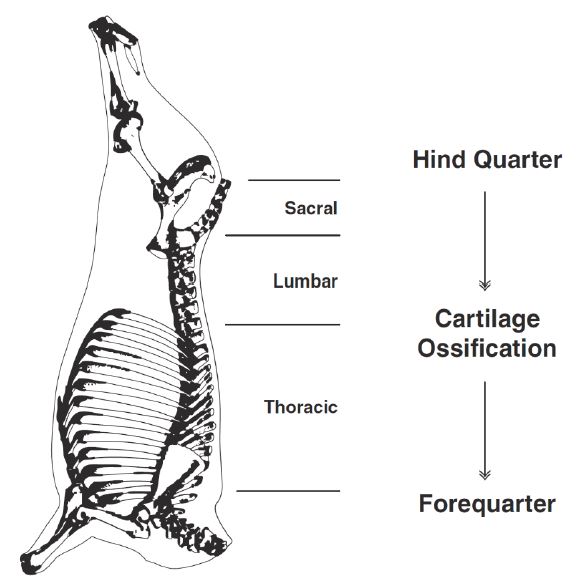
Figure 3. Skeletal structure of beef carcass showing progression of cartilage ossification in backbone.
YIELD GRADING
USDA Yield Grades estimate beef carcass cutability, which is defined as the combined yield of closely trimmed, boneless retail cuts (%CTBRC) from the round, loin, rib and chuck. This is an estimate of the relative amount of lean, edible meat from a carcass. The five Yield Grades for slaughter cattle and beef carcasses are:
USDA Yield Grade 1
USDA Yield Grade 2
USDA Yield Grade 3
USDA Yield Grade 4
USDA Yield Grade 5
The lower the numerical value of the USDA Yield Grade, the higher the yield of closely trimmed, boneless retail cuts (Table 1).
Table 1. Expected Yields of Closely Trimmed, Boneless Retail Cuts (% CTBRC) and Total Retail Cuts (% Total Yield) for Each USDA Yield Grade
|
Yield Grade |
%CTBRCa |
%Total Yieldb |
|
1 |
>52.3 |
≥80 |
|
2 |
50.0 to 52.3 |
75 to 79 |
|
3 |
47.7 to 50.0 |
70 to 74 |
|
4 |
45.4 to 47.7 |
65 to 69 |
|
5 |
<45.4 |
<65 |
-
a Includes cuts only from the round, loin, rib, and chuck.
- b Includes steaks, roasts, and ground beef from the entire carcass.
The Yield Grade of a beef carcass is determined by evaluating the following factors: (1) external fat thickness over the ribeye, (2) ribeye area, (3) estimated percentage of kidney, pelvic and heart fat (%KPH), and (4) hot carcass weight.
Fat Thickness
Fat thickness is measured at a point three- fourths of the distance of the length of the ribeye from its chine bone side (Figure 4). This single measurement is a reasonably accurate predictor of overall carcass fatness; however, to improve the accuracy of the predictions of overall carcass fatness, the fat thickness measurement usually is adjusted up or down by the grader to account for visible differences in the distribution of external fat in other areas of the carcass.
Ribeye Area and Carcass Weight
The relationship between ribeye area and carcass weight is used in Yield Grading beef carcasses to reflect differences in cutability stemming from carcass muscularity. Ribeye area normally ranges from about 9 to 17 square inches among carcasses of common weights and can be measured using a plastic grid (Figure 5).
Kidney, Pelvic and Heart Fat Percentage (%KPH)
Fat deposits around the kidney and heart, and in the pelvic cavity, typically are left in the carcass during the slaughter process and affect carcass cutability. Most carcasses have 1% to 4% of the carcass weight represented as kidney, pelvic and heart fat.
Determining USDA Yield Grades
The formula for calculating Yield Grade is:
YG = 2.5 + (2.5 x adjusted fat thickness, in.)
+ (.20 x KPH%)
– (.32 x ribeye area, sq. in.)
+ (.0038 x hot carcass weight, lbs.)
While the USDA Grader may use this equation occasionally, most determinations are based upon the Grader’s experience and training, checking occasionally with the formula when requested to do so. The same holds true for the Grader’s determination of the USDA Quality Grade.
Summary
Consumers and producers often do not have a clear understanding of beef grading. Beef grades are of two types, Quality Grades and Yield Grades. Most consumers are familiar with the names of several Quality Grades and may use them as a selection criterion when purchasing at retail. However, Yield Grades have less direct impact on consumer selection decisions. Producers, on the other hand, depend greatly on both Quality and Yield Grades as a marketing tool for beef cattle and carcasses.
USDA Quality Grades are used to predict the palatability of meat from a beef animal or carcass, using carcass physiological maturity and marbling to determine the USDA grade. USDA Yield Grades are used to estimate the expected edible lean meat, with a USDA YG 1 being the leanest and a USDA YG 5 being the fattest.
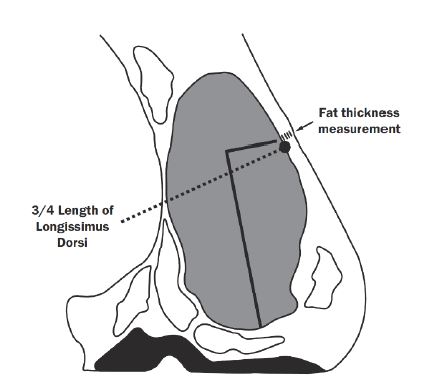
Figure 4. The location where fat thickness over the Ribeye is measured.
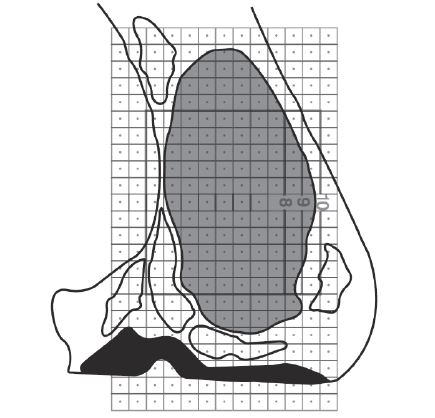
Figure 5. Method of measuring Ribeye area. In using the grid to measure a ribeye, place it on the cut surface of the ribeye and count all squares in which lean surrounds a dot. Divide the number of squares counted by 10. The resulting area is the area of the ribeye in square inches.
References
- Boggs, D.L. and Merkel, R.A. Live Animal, Carcass Evaluation and Selection Manual. Dubuque, IA: Kendall/Hunt Publishing Company, 1990. United States Department of Agriculture: Standards for Grades of Slaughter Cattle and Standards for Grades of Carcass Beef. Agricultural Marketing Services, USDA. Washington, D.C., Government Printing Office, 1996.